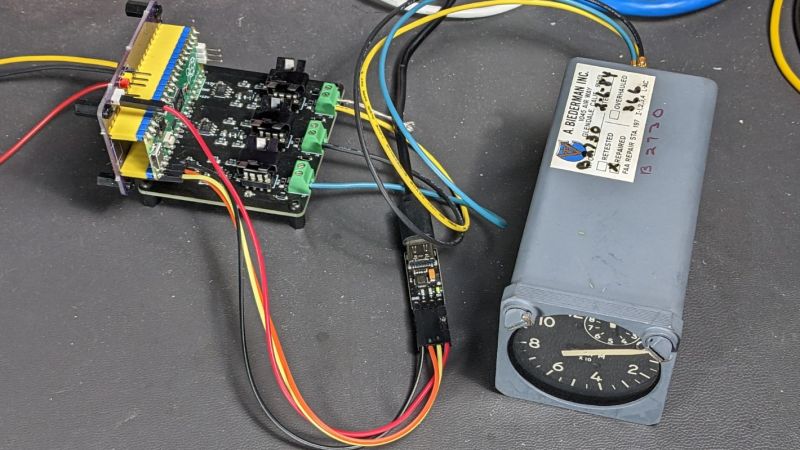When you’ve got a piece of interesting old aviation hardware on your desk, what do you do with it? If you’re not willing to relegate it to paperweight status, your only real choice is to tear it down to see what makes it tick. And if you’re lucky, you’ll be able to put it to work based on what you learned.
That’s what happened when [Glen Akins] came across a tachometer for a jet airplane, which he promptly turned into a unique CPU utilization gauge for his computer. Much of the write-up is concerned with probing the instrument’s innards to learn its secrets, although it was clear from the outset that his tachometer, from Kollsman Instruments, was electrically driven. [Glen]’s investigation revealed a 3-phase synchronous motor inside the tach. The motor drives a permanent magnet, which spins inside a copper cup attached to the needle on the tach’s face. Eddy currents induced in the cup by the spinning magnet create a torque that turns the needle against the force of a hairspring. Pretty simple — but how to put the instrument to work?
[Glen]’s solution was to build what amounts to a variable frequency drive (VFD). His power supply is based on techniques he used to explore aircraft synchros, which we covered a while back. The drive uses a trio of MCP4802 8-bit DACs to generate three phase-shifted sine waves via direct digital synthesis with an RP2040. The 3-phase signal drives the motor and spins the dial, with 84-Hz corresponding to full-scale deflection.
The video below shows the resulting CPU utilization gauge — which just queries for the current load level and sends it to the RP2040 over serial — in action. It’s not exactly responsive to rapid changes, but that’s to be expected from a mechanical system. And compared to exploring such a nice instrument, it really doesn’t matter.
















When you’ve got a piece of interesting old aviation hardware on your desk, what do you do with it?
First, check with geiger counter if it isn’t hot. Then see if it’s worth anything. If not, take it apart, sort copper, steel and aluminium. Every year or so I take my box of scrap metals to junkyard and I can earn about 50 PLN. It’s not much but it’s 50 PLN that would otherwise be thrown out into trash.
So….. don’t turn it into a neat CPU utilization meter that’s featured on a website where these sorts of projects are encouraged???
I can barely drive to the next scrapyard for 11€ lol. It’s a bit exaggerated of course, but let’s calculate:
Diesel is 1.5€/l atm. Motor is cold, so it takes a good 10l the first few Km. It’s twenty Km to the yard. Let’s say my old car sips 8.5l/100km. So it costs at least 3-3.5€ getting there. Not gonna do it for 7€ profit…
+1 for not doing the obvious with a dial that goes from 0 to 12!
One too high for measuring speaker volume ;)
“This one goes to 11!”
Broke: “Why don’t you just make 10 louder?”
Woke: “For $5000, I’ll build you one that goes to 12!”
What uses obvious thing uses 13 positions (+ gap)?
I think BT was grateful that this was not turned into a clock.
I wonder if a brushless DC motor controller would work to drive this tacho?
Reading the comments, I actually think it would be funny to make a clock out of this because it goes from 0 to 12 but the numbers aren’t in same place as a real clock. So you would have to pick making the hand(s) line up with throb numbers and making it awkward to read the time, or make the hand(s) go to “normal” clock positions but if you tried to read the numbers it would be wrong.
Either way kinda funny/annoying to people which would be worth it. I think.
And the clock would consume about 20% more power at 5 o’clock than 2 o’clock or 10 o’clock.
The motor must make some noise right?
Sound up! https://www.youtube.com/watch?v=7K5nrkncc_c
I used a supercardioid mic when making the CPU tachometer demo video so the PC noise and tachometer noise were well outside the main lobe of the mic. Next time, I’ll mic the tach too then add its noise back during post.
Very cool!
I have an attitude display (I forget what the real term is) out of a B-52 or some such. It has about ten motors and meter movement displays in it, plus lights and whatnot, all analog. I can’t think of anything to do with it except make a do-nothing box that wiggles the pointers and moves the motors on the display.